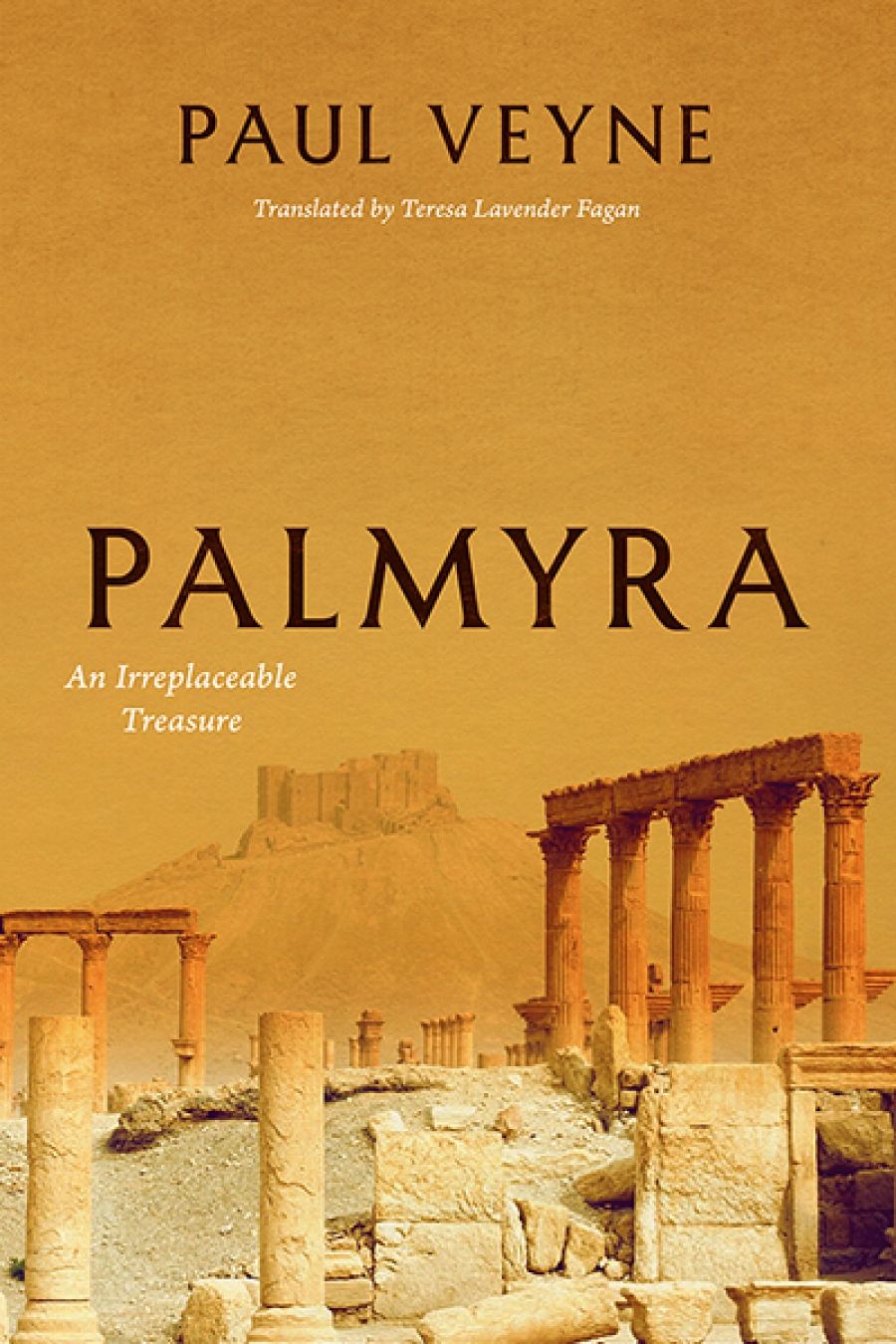
- Free Article: No
- Contents Category: Classics
- Custom Article Title: Christopher Allen reviews 'Palmyra: An irreplaceable treasure' by Paul Veyne, translated by Teresa Lavender Fagan
- Review Article: Yes
- Online Only: No
- Custom Highlight Text:
France’s higher education system can seem arcane to outsiders, especially those from the English-speaking world. Although the Sorbonne is coeval with Oxford and Cambridge, there is far greater prestige in attending one of the Grandes Écoles such as Polytechnique or the École Normale Supérieure, only accessible by notoriously ...
- Book 1 Title: Palmyra
- Book 1 Subtitle: An irreplaceable treasure
- Book 1 Biblio: University of Chicago Press (Footprint), $44.99 hb, 128 pp, 9780226427829
Paul Veyne, himself a graduate of École Normale Supérieure, was Professor of Roman History at the Collège de France from 1975 to 1999, and the author of many books including Comment on écrit l’histoire (1970) and Les Grecs ont-ils cru à leurs mythes? (1983, English tr. 1988). Now in his mid-eighties, Professor Veyne has taken up his pen once more in response to the barbarity of the Islamic State in Palmyra, and particularly the monstrous act of torturing and murdering the elderly doyen of Syrian archaeology, Khaled al-Asaad.
Veyne’s book is dedicated to the memory of Professor al-Asaad, but its real subject is the city of Palmyra: its vandalisation by the forces of Daesh, but also its history and its culture in antiquity. For the destruction of the outstanding archaeological site of the city has the singular moral ugliness of the desecration of graves, and here too the profound impiety of the act is made more poignant by a recollection of the life of the departed.
Palmyra was an oasis town on the edge of the desert, made prosperous by its position on the trade routes between east and west. Its population was ethnically Syrian, and the common spoken language was Aramaic, as through much of the east, although the language of literacy, of higher-level business and administration, was Greek throughout the Hellenised world created by the conquests of Alexander.
The city was thus a multicultural community, not only because of the cosmopolitan mixture of peoples who frequented trading centres, but also in a more intimate sense. As Veyne suggests, Palmyra was a case study in the way that cultures assimilate features of more advanced civilisations without ceasing to be themselves.
Thus the public buildings of the city show that it had adopted social structures characteristic of the Greek polis, of the city-state as autonomous political entity, even within the Roman empire, in contrast to the status of cities in the Orient generally as entirely subordinate to central government. Such fundamentally different ways of thinking about the citizen and the state explain both why the Greek cities refused to submit to the Persian empire in the fifth century BCE – a refusal which must have been perplexing to the Great King – and why the nations of the middle east still lack a mature political culture even today. And yet, although the Palmyrans had adopted aspects of polis-culture that suited their status as a relatively independent city-state, they remained oriental traders to their bones. Their wealth was based on their position at the western end of the land and sea routes that brought products from as far as way as China and Southeast Asia to the Mediterranean. Alexandria, as Veyne says, was the main outlet for this trade, but Palmyra and the ethnically Arab Petra in Jordan were also important beneficiaries.
 The Tetrapylon of Palmyra, Syria, 2010 (photograph by Bernard Gagnon)
The Tetrapylon of Palmyra, Syria, 2010 (photograph by Bernard Gagnon)
The Palmyrans were not merely providers of entrepots or even caravan transport, but active entrepreneurs, and their wealth was based on the demand for exotic imports in the Roman world. Roman appetite for such luxuries was insatiable, in spite of the traditional Roman disapproval of expensive indulgences, which they tried to curb with sumptuary laws. This word is, incidentally, mistranslated as ‘sumptuous’, one of many odd mistakes in an otherwise readable English version (for example, the French verb armer, in the naval context, means to equip, not to arm a ship, and montaient la garde is mistranslated ‘raised the guard’ when it really means ‘stood guard’).
Palmyra’s place in history, however, rests on the city’s brief rise to quasi-imperial power in the chaotic circumstances of the third century, when the Roman empire was under pressure both from external threats, from barbarian attacks as well as from the neighbouring Persian empire, more assertive under the Sassanian dynasty, and simultaneously from internal political chaos with a succession of rival emperors elevated by competing imperial armies.
 The Roman Theater of Palmyra, Syria (photograph by Jerzy Strzelecki)
The Roman Theater of Palmyra, Syria (photograph by Jerzy Strzelecki)
In this turbulent world, the ruler of Palmyra, Odaenathus, established the city as a dominant force in the Roman east by defeating the Persians; after his assassination, his widow Zenobia launched a campaign of conquest, eventually dominating an area from Egypt to modern Turkey. She went as far as to claim imperial status for her son, as ruler of the east in partnership with the emperor of the west – a suggestion that anticipated the reforms of Diocletian – before ultimately being defeated by the emperor Aurelian.
After this, Palmyra’s historical role ended and the city’s importance dwindled rapidly. For centuries it lived on only as poignant ruins in the desert, until the Islamist zealots of Daesh attempted to destroy what Veyne eloquently evokes as a place of cosmopolitanism and of exchange between East and West; for even the vestiges of an open society are intolerable to those who cling so desperately to a single dogma.


Comments powered by CComment